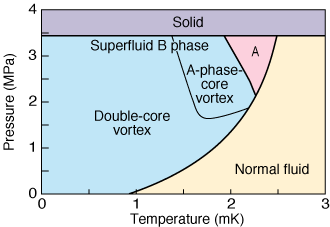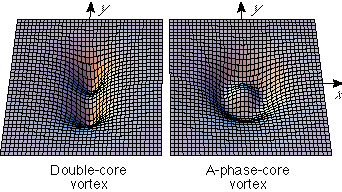
The first experiments on rotating superfluid 3He in Helsinki were made in the early 80's. They showed clear evidence that two different types of quantized vortices were present in the B phase [1]. The stability of the two depends on the temperature and pressure as indicated in the phase diagram (fig. 1). Theoretical calculations showed that both vortex types have spontaneously broken symmetry in the vortex core. In particular, the vortex that is stable at low pressures was identified with the double-core vortex, where the circular symmetry around the vortex axis is broken [2]. The amplitude of the order parameter in the cores of the two vortex lines (parallel to z) is illustrated in fig. 2. In the double-core vortex the core is split into two half cores, which resemble half-quantum vortices. The excitation spectrum in the half cores changes qualitatively as a function of pressure and temperature, see Lifshitz transition in the double-core vortex. The half cores are also related to the π state in 3He Josephson junctions.

More definitely, the two vortices above should be called mass vortices because there is a mass flow around the vortex axis. In addition to mass vortices, 3He supports also spin vortices, where the spin-up condensate circles in opposite direction than the spin-down condensate. Such metastable structures have been seen experimentally after a transition from the A phase.
There are also several types of vortices in the A phase. Their stability depends only weakly on the pressure and temperature, but there is a crucial dependence on the rotation velocity and magnetic field.
See Ref. [3] for a review of vortices in superfluid 3He.
Back to helium theory page, to helium page, to 3He page
16.5.2000, Erkki Thuneberg, Email, Suomeksi